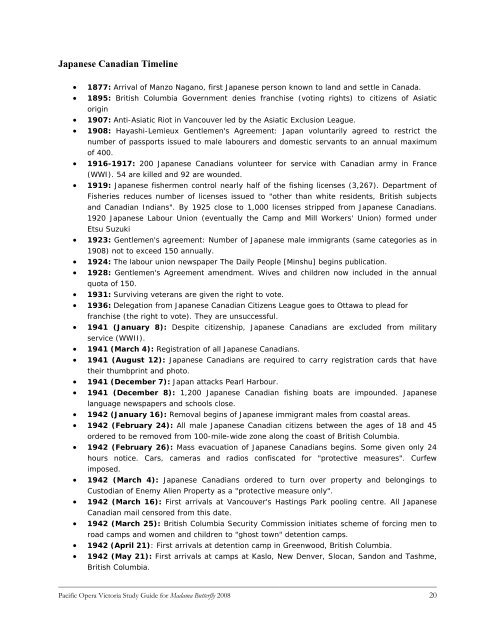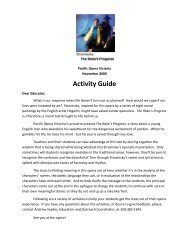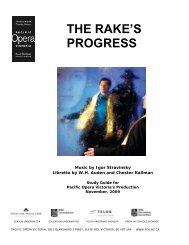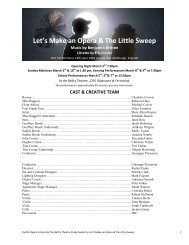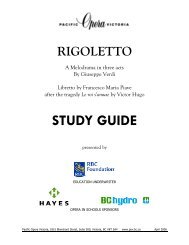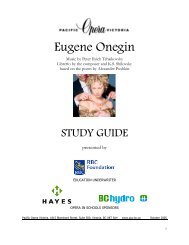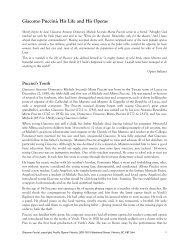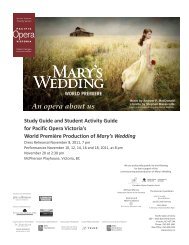Madama Butterfly Study Guide - Pacific Opera Victoria
Madama Butterfly Study Guide - Pacific Opera Victoria
Madama Butterfly Study Guide - Pacific Opera Victoria
You also want an ePaper? Increase the reach of your titles
YUMPU automatically turns print PDFs into web optimized ePapers that Google loves.
Japanese Canadian Timeline<br />
• 1877: Arrival of Manzo Nagano, first Japanese person known to land and settle in Canada.<br />
• 1895: British Columbia Government denies franchise (voting rights) to citizens of Asiatic<br />
origin<br />
• 1907: Anti-Asiatic Riot in Vancouver led by the Asiatic Exclusion League.<br />
• 1908: Hayashi-Lemieux Gentlemen's Agreement: Japan voluntarily agreed to restrict the<br />
number of passports issued to male labourers and domestic servants to an annual maximum<br />
of 400.<br />
• 1916-1917: 200 Japanese Canadians volunteer for service with Canadian army in France<br />
(WWI). 54 are killed and 92 are wounded.<br />
• 1919: Japanese fishermen control nearly half of the fishing licenses (3,267). Department of<br />
Fisheries reduces number of licenses issued to "other than white residents, British subjects<br />
and Canadian Indians". By 1925 close to 1,000 licenses stripped from Japanese Canadians.<br />
1920 Japanese Labour Union (eventually the Camp and Mill Workers' Union) formed under<br />
Etsu Suzuki<br />
• 1923: Gentlemen's agreement: Number of Japanese male immigrants (same categories as in<br />
1908) not to exceed 150 annually.<br />
• 1924: The labour union newspaper The Daily People [Minshu] begins publication.<br />
• 1928: Gentlemen's Agreement amendment. Wives and children now included in the annual<br />
quota of 150.<br />
• 1931: Surviving veterans are given the right to vote.<br />
• 1936: Delegation from Japanese Canadian Citizens League goes to Ottawa to plead for<br />
franchise (the right to vote). They are unsuccessful.<br />
• 1941 (January 8): Despite citizenship, Japanese Canadians are excluded from military<br />
service (WWII).<br />
• 1941 (March 4): Registration of all Japanese Canadians.<br />
• 1941 (August 12): Japanese Canadians are required to carry registration cards that have<br />
their thumbprint and photo.<br />
• 1941 (December 7): Japan attacks Pearl Harbour.<br />
• 1941 (December 8): 1,200 Japanese Canadian fishing boats are impounded. Japanese<br />
language newspapers and schools close.<br />
• 1942 (January 16): Removal begins of Japanese immigrant males from coastal areas.<br />
• 1942 (February 24): All male Japanese Canadian citizens between the ages of 18 and 45<br />
ordered to be removed from 100-mile-wide zone along the coast of British Columbia.<br />
• 1942 (February 26): Mass evacuation of Japanese Canadians begins. Some given only 24<br />
hours notice. Cars, cameras and radios confiscated for "protective measures". Curfew<br />
imposed.<br />
• 1942 (March 4): Japanese Canadians ordered to turn over property and belongings to<br />
Custodian of Enemy Alien Property as a "protective measure only".<br />
• 1942 (March 16): First arrivals at Vancouver's Hastings Park pooling centre. All Japanese<br />
Canadian mail censored from this date.<br />
• 1942 (March 25): British Columbia Security Commission initiates scheme of forcing men to<br />
road camps and women and children to "ghost town" detention camps.<br />
• 1942 (April 21): First arrivals at detention camp in Greenwood, British Columbia.<br />
• 1942 (May 21): First arrivals at camps at Kaslo, New Denver, Slocan, Sandon and Tashme,<br />
British Columbia.<br />
________________________________________________________________________________________________________<br />
<strong>Pacific</strong> <strong>Opera</strong> <strong>Victoria</strong> <strong>Study</strong> <strong>Guide</strong> for <strong>Madama</strong> <strong>Butterfly</strong> 2008 20


